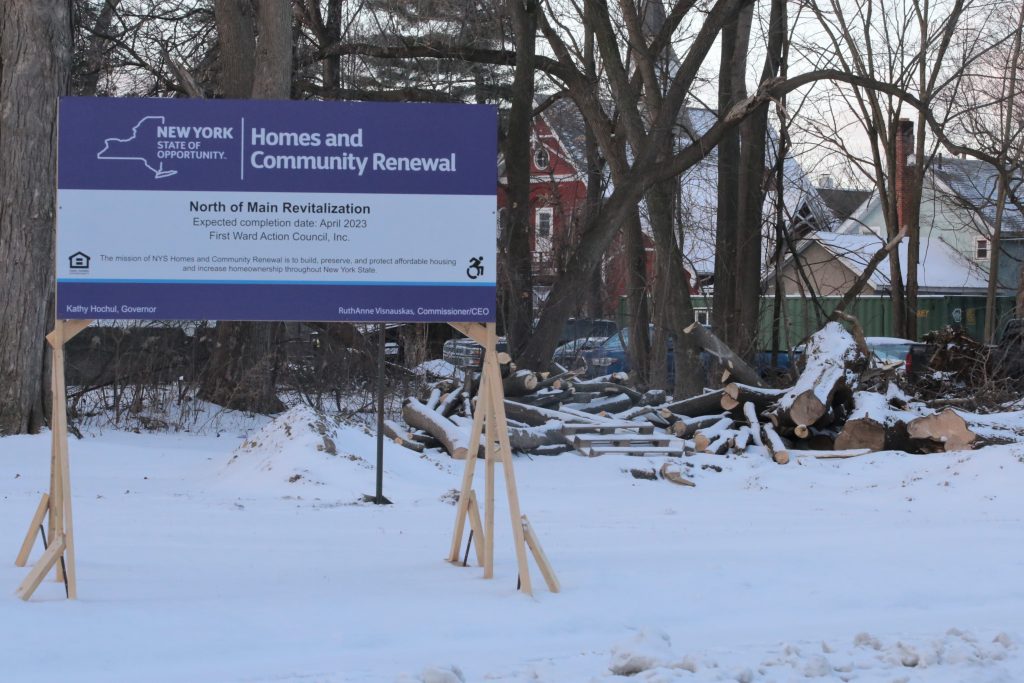The First Ward Action Council’s (FWAC) West Side construction project is now underway.
The FWAC, a nonprofit organization specializing in developing and expanding housing in Broome County, has been certified by the Department of Housing and Urban Development and funded by the New York State Homes and Community Renewal Neighborhood Preservation Program since 1982. The FWAC has put nearly $30 million into community housing projects, including the $11 million Crandall-North Street Revitalization Project in 2018. FWAC’s newest construction project is located at 95 Walnut St.
Before construction began, the FWAC helped current tenants find temporary, suitable housing at a variety of other locations, according to Jerry Willard, executive director of the FWAC. Willard said the final housing project will cater to lower-income residents in Binghamton.
“It’s low-moderate income housing,” Willard said. “The rents are lower, and the units are only available to people who have lower incomes. Our projects usually end up looking very nice, improving the neighborhood and providing affordable housing. Another one a couple years ago turned out very well — Crandall Street. We assume that this one will end up being equally as nice.”
Willard also said that FWAC has another housing project for Vestal’s senior citizens coming soon.
Binghamton Mayor Jared Kraham said the housing project is intended to “restore integrity” to Binghamton’s West Side by providing affordable and safe housing up to code, with 23 new affordable homes being introduced to the housing market.
George Homsy, board member for the North of Main, a community organization located at 85 Walnut St., and an associate professor of public administration at BU, wrote that FWAC’s Crandall Street project renovated about a dozen properties into affordable housing for low-income families and single people.
“The FWAC takes care of their properties and the streets they are on, making them feel more comfortable for all residents,” Homsy wrote in an email. “The lawns are mowed, buildings are repaired and trash is picked up.”
The FWAC applies for the majority of its funding through a federal program that provides low-income housing tax credits which, if secured, are sold to private investors, according to Willard. The city of Binghamton is contributing $355,000 in funding for this project, according to Kraham.
Kraham said the FWAC’s construction projects contribute more than new housing to the community.
“The FWAC has a long track record of developing affordable homes in the city of Binghamton,” said Kraham. “From the Front Street Gateway project to the Lincoln Court Apartments, to this project and the [Crandall-North Street] Revitalization Project, these are all positive, impactful initiatives for the neighborhood. Another project moving forward is creating short-term construction jobs and long-term solutions for affordable housing. We can use affordable housing developments to make investments in public safety, infrastructure and affordable housing, which restores integrity to the neighborhood and provides people with safe, quality affordable homes.”
Rachael Warner, ‘18, had interned with the FWAC and wrote the FWAC was one of a few developers in Binghamton who was improving the city’s housing stock without major profit incentives.
“In addition to its role as a developer, FWAC also manages these properties and offers homes to residents of all incomes, provides emergency housing, offers repair services and administers grant programs to homeowners,” Warner wrote. “I think FWAC is an incredible resource for the Binghamton area and will continue to be instrumental in revitalization efforts going forward.”
Karen Barzman, a professor of art history, wrote the FWAC’s projects improving housing conditions have benefited both BU students and Binghamton residents in areas with heavy numbers of both.
“And unlike the new ‘luxury’ options for student housing in Downtown Binghamton and Vestal, this housing on the West Side, north of Main Street, was (and in many cases still is) owned by delinquent landlords with poor management of their properties (with numerous code violations),” Barzman wrote in an email. “Students were living in dilapidated apartments, in horrendous conditions, next door to Binghamton residents forced to live in similar circumstances.”
KT Fitzgerald, a junior majoring in psychology, said Binghamton needs more affordable housing and attributed increasing housing prices to student housing.
“There is ample housing, but none of it is affordable,” Fitzgerald wrote. “People are spending most of their limited funds on rent in a time where the price of existing housing has skyrocketed with no rise in wages. Student housing has exploded and has artificially inflated property values and rent prices, exploiting students and leaving local families with no place to comfortably live.”



